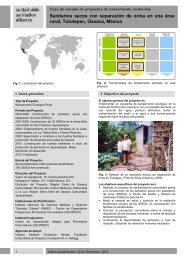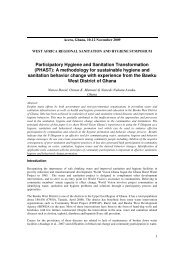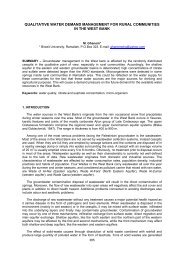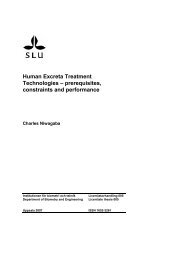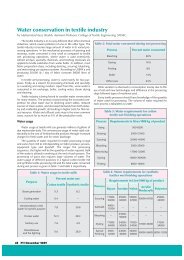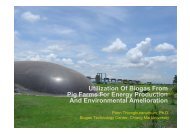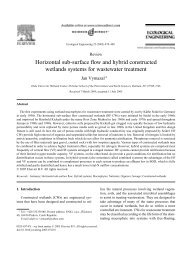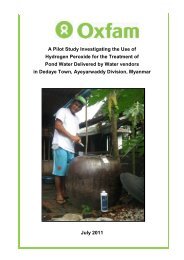Fertigation: Optimizing the Utilization of Water and Nutrients - SSWM
Fertigation: Optimizing the Utilization of Water and Nutrients - SSWM
Fertigation: Optimizing the Utilization of Water and Nutrients - SSWM
You also want an ePaper? Increase the reach of your titles
YUMPU automatically turns print PDFs into web optimized ePapers that Google loves.
where Venturi-‐type or proportional pumps are used to inject <strong>the</strong> dose <strong>of</strong><br />
fertilizer solution from a storage tank into <strong>the</strong> irrigation line.<br />
Urea, ammonium nitrate, calcium nitrate, potassium nitrate <strong>and</strong> ammonium<br />
phosphate, are soluble in water <strong>and</strong> are used extensively to prepare single-‐ or<br />
multi-‐nutrient fertilizer solutions. Mono-‐ammonium phosphate, phosphoric acid<br />
<strong>and</strong> urea phosphate are also water soluble, but <strong>the</strong>y may precipitate when<br />
injected at high rates into “hard” water, i.e., containing high concentrations <strong>of</strong><br />
calcium <strong>and</strong> magnesium carbonates. All potassium fertilizers are water-‐soluble<br />
but vary in <strong>the</strong>ir rates <strong>of</strong> dissolution <strong>and</strong> <strong>the</strong>ir sensitivity to temperature; KCl is<br />
<strong>the</strong> most widely used potassium fertilizer for field crops.<br />
Compatibility <strong>of</strong> fertilizers<br />
Mixing two fertilizers can sometimes result in precipitation. For example,<br />
injection <strong>of</strong> a calcium salt with phosphate or sulfate may increase <strong>the</strong> likelihood<br />
<strong>of</strong> calcium phosphate or calcium sulfate precipitation, even at low pH. The pH<br />
<strong>of</strong> <strong>the</strong> irrigation solution should be within <strong>the</strong> range 5.5 to7.0. Too high a pH<br />
will reduce <strong>the</strong> availability <strong>of</strong> P, Zn <strong>and</strong> Fe, <strong>and</strong> may result in precipitation <strong>of</strong> Ca<br />
<strong>and</strong> Mg phosphates or carbonates in <strong>the</strong> irrigation lines. Too low a pH is<br />
detrimental to roots <strong>and</strong> may increase Al <strong>and</strong> Mn concentrations in <strong>the</strong> soil<br />
solution. Nitric (HNO3) or phosphoric (H3PO4) acids are used to lower <strong>the</strong> pH<br />
level in fertigation. Their advantage, besides dissolution <strong>of</strong> basic precipitates in<br />
<strong>the</strong> line, is that <strong>the</strong>y also supply <strong>the</strong> plants with <strong>the</strong> essential nutrients, <strong>and</strong><br />
<strong>the</strong>reby replace N <strong>and</strong> P fertilizers. In saline waters <strong>and</strong> calcareous clay soils<br />
nitric acid increases Ca dissolution <strong>and</strong> <strong>the</strong>reby minimizes salinity injury,<br />
because <strong>of</strong> Ca/Na competition, <strong>and</strong> reduces <strong>the</strong> chloride salinity in <strong>the</strong> root zone,<br />
because <strong>the</strong> nitrate counterbalances excess chloride (Xu et al., 2000).<br />
Precipitation in <strong>the</strong> irrigation lines<br />
Precipitation <strong>of</strong> insoluble di-‐calcium phosphate, di-‐magnesium phosphate <strong>and</strong><br />
calcium carbonate, could develop when high-‐pH water is used. Iron phosphate,<br />
originating from wells containing divalent iron, might precipitate in drip lines<br />
even at low pH water. <strong>Water</strong> containing high concentrations <strong>of</strong> Mg ions might<br />
cause ammonium magnesium phosphate precipitation in <strong>the</strong> fertilizer tank.<br />
Avoiding <strong>the</strong> use <strong>of</strong> ammonium fertilizer in such conditions can avoid <strong>the</strong> risk<br />
<strong>of</strong> blocking <strong>the</strong> emitters. Using K2SO4 or (NH4)2SO4 with water containing high<br />
concentrations <strong>of</strong> calcium might result in CaSO4 (gypsum) precipitates that<br />
could clog <strong>the</strong> drip lines.<br />
17



